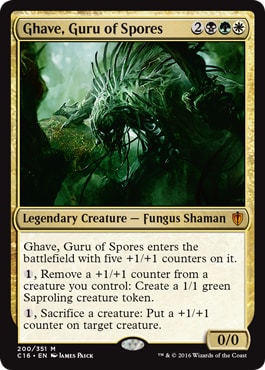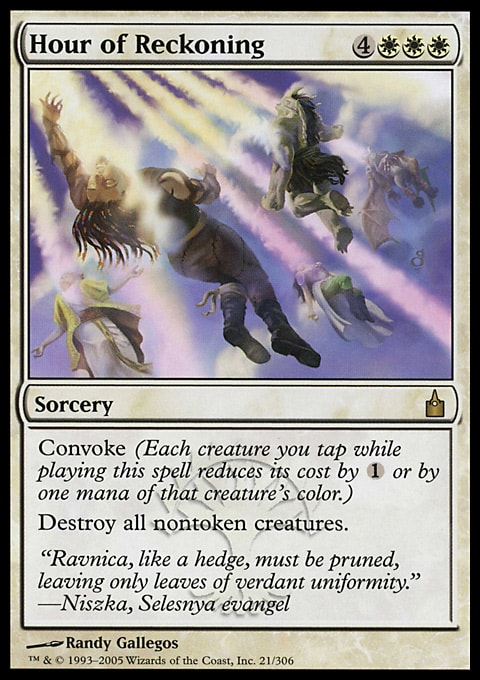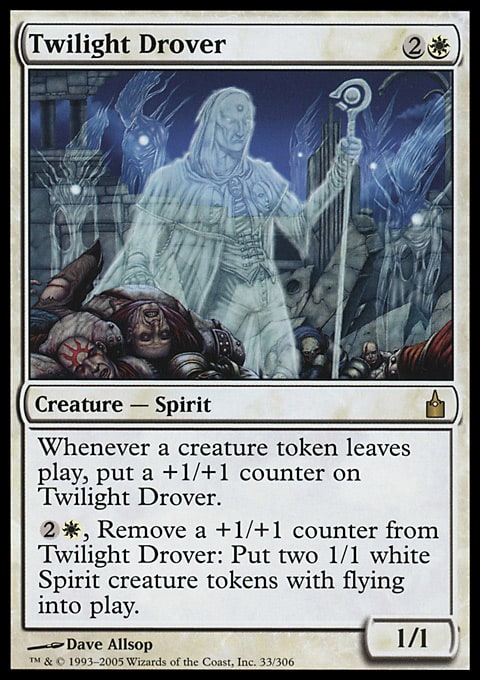I was considering running a new project budget Commander anyway, but reading Brandon’s great article inspired me to push to it. You can find his article here.
I’ve seen people write budget decks that clock in at $100 or more! Folks, that is not a budget deck, that’s a normal deck! Now, to be fair, any deck that uses cards you already own is cheaper than one that uses a bunch of cheap cards you don’t. So, if a deck list has cards that clock in at $255, but I already owned the cards, it’s really free to me. (That’s still not worthy of a budget article, though!)
To begin with, I didn’t want a Commander selection so cheap that it ruined my ability to build a deck. Yet, I wanted something that truly said, “Build a deck around me!” I pulled over to CoolStuffInc.com and did a search for every legendary creature that clocked in at $2 or fewer. Then, I found my commander—one I’ve been eying for a while. Clocking in at a beautiful $1.49 was Ghave, Guru of Spores. (Note that prices can change from when this article is written or published to when it is read, as cards change in value daily.)
I want to beat my prior price and come in under $35. (This assumes cards are picked up at near-mint costs; sometimes, cards can be acquired far more cheaply in played condition.)
"Ghave, Budget of Spores"
- Commander (0)
- Creatures (34)
- 1 Acidic Slime
- 1 Avenging Druid
- 1 Bloodgift Demon
- 1 Champion of Lambholt
- 1 Consumptive Goo
- 1 Corpsejack Menace
- 1 Dark Impostor
- 1 Fertilid
- 1 Golgari Guildmage
- 1 Healer of the Pride
- 1 Indrik Stomphowler
- 1 Jade Mage
- 1 Juniper Order Ranger
- 1 Korozda Gorgon
- 1 Korozda Guildmage
- 1 Krosan Tusker
- 1 Mentor of the Meek
- 1 Mindwarper
- 1 Mold Shambler
- 1 Nekrataal
- 1 Plaguemaw Beast
- 1 Renegade Krasis
- 1 Selesnya Guildmage
- 1 Simic Basilisk
- 1 Spike Cannibal
- 1 Spike Feeder
- 1 Sporeback Troll
- 1 Suture Priest
- 1 Thelonite Hermit
- 1 Verdant Force
- 1 Mindless Automaton
- 1 Triskelion
- 1 Emmara Tandris
- 1 Verdeloth the Ancient
- Spells (30)
- 1 Crushing Vines
- 1 Crypt Incursion
- 1 Doom Blade
- 1 Expunge
- 1 Fresh Meat
- 1 Harrow
- 1 Natural End
- 1 Oblation
- 1 Rend Flesh
- 1 Seed Spark
- 1 Sprout Swarm
- 1 Swell of Courage
- 1 Collective Unconscious
- 1 Death Mutation
- 1 Diabolic Tutor
- 1 Down // Dirty
- 1 Hour of Reckoning
- 1 Spread the Sickness
- 1 Unburial Rites
- 1 Cathars' Crusade
- 1 Fecundity
- 1 Golgari Germination
- 1 Martyr's Bond
- 1 Necrogenesis
- 1 Contagion Clasp
- 1 Contagion Engine
- 1 Druidic Satchel
- 1 Nihil Spellbomb
- 1 Vessel of Endless Rest
- 1 Whispersilk Cloak
That’s a total cost of $36.48. I came in just over my $35 budget but below the line of my previous deck. Yay!
I wanted to make this more than just a Counterpunch rebuild, but as I started adding cards, I wanted to include guys such as Death Mutation, Hour of Reckoning, and Necrogenesis that were in the Counterpunch deck. Yet, I was also able to add a lot of new stuff.
I emphasized both themes of Ghave: making Saprolings and +1/+1 counters. Most Ghave decks focus on token-making and include anything that makes tokens, but I settled on just the Saprolings. Mostly, I just included cards that worked with Saprolings and +1/+1 counters.
As I begin to count off great cards, I noticed that a ton of good, quality cards for this deck charted in the $2 to $3 range. I could not play them all with my tight budget. So, what made the cut, what didn’t, and why?
Let’s begin with the Saproling cards. First of all, you need to make Saprolings, so in went a few cards here and there. Jade Mage will spawn some, as will Selesnya Guildmage. Both jumped in since I like to have a few lower-casting-cost cards in my deck to do things in the first few turns of Commander. Korozda Guildmage jumped in as well. It will sacrifice a nontoken creature (using 4 mana) to make number of Saproling dorks to equal the sacrificed one’s power. Considering the large number of creatures the deck runs, that’s a good deal. Then, we have Necrogenesis to exile creatures from graveyards and make Saprolings in all of the latest style (hearkening all of the way back to Night Soil in Fallen Empires). Don’t forget Druidic Satchel, which can make a dude, gain some life, or flop a land into play. Since the deck is roughly one third each of those, you’ll find all of them activating at various times.
And that’s not all. We have Verdant Force to make Saproling tokens at a prodigious clip. It’s nice to fit in an old-school fatty and Saproling-maker like it. It has a low cost these days due to massive overprinting. We also have the instant buyback-plus-convoke stylings of Sprout Swarm. It’s great to play it instantly at the end of someone’s turn, tap down some creature to make a few tokens, and then untap having produced two or three other Saprolings. Seed Spark gives the deck some Disenchanting while also producing two Saprolings. Another spell that makes Saprolings while doing something is Death Mutation. Not only does it kill something, but it makes an army for your trouble. It’s worth the price. Let’s not forget either the Golgari Germination, which will churn out a Saproling when a nontoken dies or the City-Tree land. Those’re a lot of ways to make Saprolings.
Then, we have a few Saproling enablers. The first is our solitary morph card Thelonite Hermit. It can morph up to make some Saprolings as well as pump all of our poor lil’ Saprolings a bit. Sure, it’s no secret what morph card it is, but it still rules strongly enough for inclusion. One old powerhouse for Saprolings is Verdeloth the Ancient; it might feel odd in Modern Masters, but it is right at home here. You can put some mana into it to make Saprolings while it also pumps the team of these guys. He works well in this deck since he’s a great mana sink. Probably due to Verdeloth’s multiple printings, it’s priced significantly lower than good ol’ Nemata. I was unable to fit the Grove Guardian into my deck.
Now let’s turn to consider the +1/+1 cards. First of all, I wanted cards that used these counters. I loved Korozda Gorgon for its ability to strip off counters to kill others. Golgari Guildmage is powerful because you can use extra mana to load up some +1/+1 counters or sacrifice a creature (such as a Saproling) to Raise Dead a creature.
Spike Cannibal is downright disgusting in many metagames. It’s a 3-mana creature that moves all +1/+1 counters on all creatures around the table to it when it arrives. That means it may hurt a few creatures of your own, but it will produce a nasty-large creature to smash face. If you need that, it will provide a body. Otherwise, it will hurt some board positions, so play carefully with it.
Juniper Order Ranger puts a token on something that arrives as well as itself. That gives 2 counters for the price of no mana at all. That’s a nice way to load stuff up. Meanwhile, we can make tokens with Swell of Courage. It’s like a Howl from Beyond in white that leaves +1/+1 counters on the creature. That’s nasty-good. It can also just be played to pump the horde +2/+2 for a turn like a small Overrun. Therefore, both forms work well here with either half of Ghave. Any deck like this that missed Gavony Township should feel really sad at the missed opportunity. Another similarly powerful card that will empower the deck is Cathars' Crusade. With Ghave alone, you can pull off a counter to make a token creature and then put a +1/+1 counter on everything (including Ghave)—and then repeat for as much mana as you want, making a 1/1 token for an army that grows and grows. Cathars' Crusade breaks open Ghave.
Then, I added in creatures that used and made counters. Take Fertilid; it arrives with 2 +1/+1 counters and can spend some mana to pull 1 off to fetch a land into play. Or we have Triskelion that turns +1/+1 counters into direct damage and has been doing it for a lot of years. It’s probably the best-designed card from Antiquities. Mindless Automaton is another classic for a deck like this. You can pull off 2 counters to draw a card. Mindwarper is an old-school card most people don’t remember. Check it out! It arrives with three +1/+1 counters, and for 3 mana, you can pull 1 off to force a discard. You can load it with counters and activate it several times to pull some serious cardage out of hands. One more creature that uses up counters is Spike Feeder, which converts +1/+1 counters into life.
A late addition was Corpsejack Menace, which will double the +1/+1 counters you place on creatures; it’s like a miniature Doubling Season. It was so good that I went over budget for it since it’s around $2 for a NM copy. Then, I added in creatures that just have counters through normal interaction. For example, Champion of Lambholt is a cheap enough at 3 mana but grows very quickly with counters, and it is harder to block as time goes on and it grows. While the two graft creatures—Sporeback Troll and Simic Basilisk—move counters to other creatures, their main reason for inclusion is to give my horde regeneration and quasi-deathtouch. It’s hard to attack into a group that has a Basilisk and 2 mana available. Any untapped defender can suddenly envenom and kill any attacker it engages.
Consumptive Goo is nice because it can shrink an opposing creature while growing with counters. It’s another card people often skip that’s a strong card for this sort of deck. Another is Dark Impostor. It exiles stuff for 6 mana as well as growing. That alone is worth playing in a Ghave deck, so netting extra abilities on it is just gravy.
Once I had these powerful cards for Saprolings and counters, I began to look for other things that worked with them. That led me to proliferate and Spread the Sickness, and the Contagion artifacts came in. I also uncovered Plaguemaw Beast, who can tap to sacrifice any creature (including a Saproling) to proliferate. That’s pretty good here.
I wanted some card-draw, and Mentor of the Meek jumped in. Note that this triggers when Saprolings enter the battlefield, so a bit of mana can be spent to draw some cards. Another card-draw option was Fecundity. Sure, anyone can draw cards when creatures die, but I expect this deck to be losing many more. Another card that should prove useful when my guys die is Martyr's Bond. It’s better than Grave Pact, easier on the mana, and cheaper to purchase. Another powerful choice is Collective Unconscious. Take a look at that thing if you’ve forgotten it. Ouch. I couldn’t fit in Harmonize, which costs $1.50 to $0.50 for the CU. But it looks better in most situations
Last, I added cards that flesh out the deck. This included normal card such as Acidic Slime and Diabolic Tutor as well as Expunge, Oblation, and Natural End. I like Crushing Vines as a Shatter or a Plummet and that gives some nice versatility. Mold Shambler is Acidic Slime’s junior partner, and Indrik Stomphowler is its big brother. I even found space for Nekrataal. I felt pushing these creatures was useful in a deck that really wanted to work with my creatures. Sure, I included some instant removal as needed, but creature-based removal was my preferred choice.
I also followed that logic for Krosan Tusker. It can cycle for a land and a card early, and it’s a decent beater late. Both serve the deck’s needs. I also included Avenging Druid, a lesser-known force that can yield quite a few lands over the course of the game.
Unburial Rites is nice to Zombify one creature now and hold onto a flashback for another later. I wasn’t able to fit in a lot of reanimation, but I didn’t want to write it off wholesale. I managed to add Down // Dirty to the deck to give a nice Recollect and a Mind Rotish option if desired. To fight graveyard abuse, I rolled with Crypt Incursion, which is a brilliant instant to gain life and to strip creatures out of a graveyard. I also ran the Nihil Spellbomb when I realized it was a lot cheaper than I figured it would be. My trio that includes the Necrogenesis was enough to give me some game there. I didn’t have enough money for a Bojuka Bog.
A few cards were added around this layer. Hour of Reckoning was a decent enough removal spell because it would save my Saprolings. Due to my Wrath of God weakness, Fresh Meat jumps in as a way to counter the effects. You can also use it after sacrificing a bunch of Saproling creatures in one turn and then making a passel of 3/3 dorks. It is the only way to make a non-Saproling token in the deck, but it was too cute to refuse. I had enough space for Suture Priest and Healer of the Pride, and gaining life from my creatures seems really potent. Whispersilk Cloak protects a key creature and also enables the ability to swing through a clogged-up defense when necessary.
The final slot in the deck went to underwhelming and much-maligned Emmara Tandris. I figured this was as good enough of a home as any!
Other good cards you might include Mycoloth, Asceticism, Vigor, Doubling Season, Lightning Greaves, Obzedat's Aid, and more. I wish Commander would have allowed me to run Simic Guildmage just playing the green half of the card. It would have been great here.
I considered a variety of cards, but for financial reasons, they clocked in at the $3-or-less spot, and I was unable to fit them into the deck. At $3 were Forgotten Ancient and Spike Weaver—obviously powerful here. At $2, I missed out on Twilight Drover, Nemata, Grove Guardian, Plague Wind, Necropolis Regent, and Cytoplast Root-Kin. At a buck and a half, I was missing Golgari Grave-Troll, Harmonize, Glare of Subdual, Profane Command, and Vulturous Zombie. At a buck were Unmake and Crib Swap. Butcher of Malakir, Mortician Beetle, and Dirtcowl Wurm came in at $0.75, but I’m not sure I’d run them anyway.
If I add $10 to my deck, I would add Twilight Drover, Forgotten Ancient, Vulturous Zombie, Nemata, and Profane Command, and I would pull out Emmara Tandris, Suture Priest, Avenging Druid, Nekrataal, and Whispersilk Cloak for them.
You can always build great decks on the cheap. It’s just a matter of finding the right card that fits the deck perfectly and cheaply. Great cards for Ghave, such as Sporeback Troll, Dark Impostor, Mindwarper, and Mindless Automaton don’t cost a lot to acquire. When you add cheap engines such as Cathars' Crusade to the deck, you wind up with a powerful deck.
I hope you enjoy it!
See you next week,
Abe Sargent































